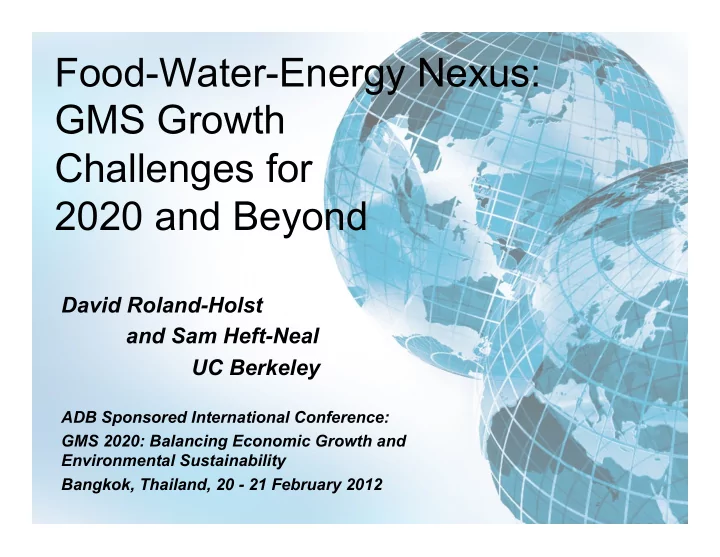

Food-Water-Energy Nexus: GMS Growth Challenges for 2020 and Beyond David Roland-Holst and Sam Heft-Neal UC Berkeley ADB Sponsored International Conference: GMS 2020: Balancing Economic Growth and Environmental Sustainability Bangkok, Thailand, 20 - 21 February 2012
Motivation Ø Unrealized agrofood and hydroelectric potential in the GMS are immense and could be guarantors of sustained prosperity. Ø This region’s climate and soils are congenial to very high agricultural productivity, but investment in agriculture is severely constrained by low average incomes. Ø Seasonal rainfall and elevation change across the GMS confer enormous hydroelectric potential, but again investments thus far have only realized a small fraction of this. Ø Investments that stabilize and more effectively distribute annual water flows, while at the same time harvesting renewable energy, could dramatically increase per capita agrofood production and incomes, securing the basis for long term growth and regional economic convergence. Ø This situation presents a strong case for active policy intervention, promoting public and/or external investment to unlock the subregion’s energy and agrofood potential. 20 February 2012 Roland-Holst & Heft-Neal 2
Cumulative Hydropower Capacity in the Mekong Basin (including projects with announced planned completion date) 35000 30000 25000 (Estimated) Hydrocapacity 20000 15000 10000 5000 0 1970 1980 1990 2000 2010 2020 20 February 2012 Sources: WB (2010); MRC (2010); King et al (2007) Roland-Holst & Heft-Neal 3 Year
Mekong Hydroelectric Capacity (Shares of Potential, Existing, Planned) 20 February 2012 Roland-Holst & Heft-Neal 4 Source: Author estimates from regional official data
Irrigation Infrastructure Projects Weighted by Volume Diverted Source: Author estimates from MRC database 20 February 2012 Roland-Holst & Heft-Neal 5
Rice yields Per Hectare Per Year Source: Author estimates from ntional, FAO, and MRC data. 20 February 2012 Roland-Holst & Heft-Neal 6
Beware of Trade-offs: Low food prices are more important to the poor than low energy prices. 50% of World Population Source: World Bank LSMS data archive. Roland-Holst & Heft-Neal 7 20 February 2012
Scenarios for Regional Resource Development and Change 1. Baseline: Calibrating the regional economies to a detailed global database, we project using consensus estimates for “Business as Usual” policies. 2. Climate Change (CC): Reduction in annual Mekong water available to agriculture, 20% less than Baseline by 2030. 3. Accelerated Hydroelectric Power Development (Hydro): Double average planned rates of GMS hydropower expansion, from 3.7%/yr to 7.6%, targeting 20% of potential by 2030. 4. Irrigation Investment (Agro) – Expanded water storage and conveyance raise irrigated agricultural capacity by 5%/yr. 5. Regional Economic Integration (REI): Assume that the in GMS countries the stock of FDI rises to at least 10% of GDP by 2030. We further assume that barriers to trade in electric power and agrofood products are removed. Note: Scenarios are sequentially inclusive. Roland-Holst & Heft-Neal 8 20 February 2012
Macroeconomic Impacts: Real GDP (percent change from Baseline in 2030) 150%% 130%% 110%% 90%% CC% 70%% Hydro% 50%% Agro% 30%% REI% 10%% !10%% Cambodia% Lao%PDR% Viet%Nam% China!GMS% Thailand% All%GMS% !30%% Roland-Holst & Heft-Neal 9 20 February 2012
Regional Integration and Economic Convergence 160%( Percent(Change,(Real(Agrofood(Output( Lao(PDR( 140%( 120%( Viet(Nam( 100%( (2010530)( Cambodia( Thailand( 80%( 60%( PRC5GMS( 40%( 20%( 0%( (365(( (3,650(( Per(capita(Annual(Income((2010(USD5PPP)(5(Logarithmic( Roland-Holst & Heft-Neal 10 20 February 2012
Salient Findings Ø Climate-induced water scarcity could adversely affect GMS agriculture, but this can be offset by agrofood productivity growth. Ø The benefits of hydroelectric development alone, without complementary water development for agriculture, are mixed. Ø Including agrofood water development strategies more than doubles the benefits of hydro alone for each country. Ø Policies that facilitate regional integration, implicating private agency including enterprise investment and supply chain integration, significantly amplify the benefits of resource development strategies, nearly doubling gains across the GMS as a whole. Ø Integration gives its biggest growth stimulus to the lower income GMS countries. Roland-Holst & Heft-Neal 11 20 February 2012
Conclusions Ø The Greater Mekong Sub-region (GMS) encompasses renewable fresh water resources that offer enormous potential for agrofood and renewable energy production. Ø Using a dynamic forecasting model that tracks five national economies included in the subregion and their linkages the global economy, we find that investments in water infrastructure and efficiency can indeed promote stronger and more inclusive regional growth. Ø The greatest potential lies with integrated storage and conveyance systems that support water’s three leading ecosystem services: food security, public health, and renewable energy. Ø Our results also suggest that institutional innovation, especially more determined initiatives to promote regional economic integration, will be essential to fulfill the vast economic promise of the subregion for all its inhabitants, especially the poor. 20 February 2012 Roland-Holst & Heft-Neal 12
Thank you 20 February 2012 Roland-Holst & Heft-Neal 13
Recommend
More recommend